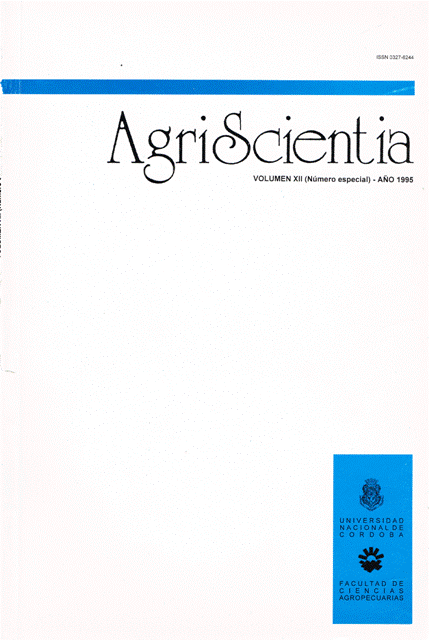Evaluation of a peanut yield model as a tool for crop planning and management
Main Article Content
Abstract
Crop management and the evaluation of strategies for better agricultural crop performances may be successfully achieved by using crop growth models. In order to provide a peanut crop growth model for such purposes, experimental trials were developed in the area of Carnerillo and Río Cuarto in the Province of Córdoba, Argentina. Using experimental data from the crop, meteorological data, and soil data from three crop seasons for each area, the PNUTGRO V1.02 peanut crop growth model was calibrated. Model evaluations in both experimental sites have shown satisfactory estimations of the dates of the phenological stages. The error in estimating grain yield in Río Cuarto was 9.6 % and 18.8 % in Carnerillo. Errors in the simulation of the biomass were greater, up to 32 % in Río Cuarto and 16 % in Carnerillo. The goodness of the model, mainly in the simulation of the crop growth stages and the grain yield, shows the use of the model as promising.
Article Details

This work is licensed under a Creative Commons Attribution-ShareAlike 4.0 International License.
How to Cite
References
Boggess, W. G. (1989). Using models in economic and risk analysis. En A. Weiss (Ed.), Proceedings of Climate & Agriculture-Systems Approaches to Decision Making (pp. 213-228). Charleston, South Carolina, 5-7 March 1989.
Boote, K. J., Jones, J. W., Hoogenboom, G., Wilkerson, G. G., & Jagtap, S. (1989). PNUTGRO V1.02 Peanut crop growth simulation model. University of Florida, Gainsville, FL.
Decker, W. L., Achutuni, V. R., & Dhakhwa, G. (1991). Simulated effects of a doubling of carbon dioxide on corn production in portions of the Central U.S. Final report to U.S. Department of Energy. Cooperative Institute for Applied Meteorology, Department of Atmospheric Sciences, University of Missouri-Columbia.
Instituto Nacional de Tecnología Agropecuaria - Ministerio de Agricultura, Ganadería y Recursos Renovables de Córdoba. (1991). Carta de suelos de la República Argentina, Hoja 3363-14, General Cabrera. Plan mapa de suelos, Córdoba.
Jones, C. A., & Kiniry, J. R. (1986). CERES-Maize: A simulation model of maize growth and development. Texas A & M University Press.
Jones, J. W. (1989). Integrating models with expert systems and databases for decision making. En A. Weiss (Ed.), Proceedings of Climate & Agriculture-Systems Approaches to Decision Making (pp. 194-211). Charleston, South Carolina, 5-7 March 1989.
Maas, S. J. (1992). GRAMI: A crop growth model that can use remotely sensed information. U.S. Department of Agriculture, Agricultural Research Service, ARS-91.
Miller, B. C., Foin, T. C., & Gill, J. E. (1993). CARICE: A rice model for scheduling and evaluating management actions. Agronomy Journal, 85(4), 938-947.
Ravelo, A. C., & Dardanelli, J. L. (1993). Calibración y validación de un modelo de simulación de rendimiento para maní (Arachis hypogaea L.). Revista de la Facultad de Agronomía, U.B.A. (en prensa).
Ritchie, J. T. (1989). Crop models and decision making: Scenario for the future. En A. Weiss (Ed.), Proceedings of Climate & Agriculture-Systems Approaches to Decision Making (pp. 106-117). Charleston, South Carolina, 5-7 March 1989.
Rosenzweig, C., & Parry, M. L. (1993). Potential impacts of climate change on world food supply: A summary of a recent international study. En H. M. Kaiser & T. E. Drennen (Eds.), Agricultural dimensions of global climate change (pp. 311-319). St. Lucie Press.
Seiler, R. A. (1980). Estimación de la radiación global en Córdoba (Argentina). Revista de Investigación Agropecuaria, 15(3), 355-377.
Willmott, C. J. (1982). Some comments on the evaluation of model performance. Bulletin of the American Meteorological Society, 63, 1309-1313.
Whisler, F. D., Trent, A., Reddy, V. R., Amonson, P., Hodges, H. F., & Acock, B. (1993). On-farm validation of the soybean simulation model, GLYCIM. Agronomy Abstracts, American Society of Agronomy, Crop Science Society of America, Soil Science Society of America, Cincinnati, OH, pp. 20.





